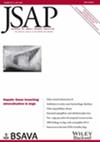Perceptions, practices and preferences of veterinarians and veterinary nurses in the UK on consent for cardiopulmonary resuscitation in pets
Abstract
Objectives
Cardiopulmonary resuscitation can be a difficult topic to discuss. The barriers surrounding its discussion are well documented in human medicine but have not previously been examined in veterinary medicine. The objectives of this study is to describe the perceptions, practices and preferences of veterinarians and registered veterinary nurses towards discussing cardiopulmonary resuscitation with pet owners.
Materials and Methods
An online survey was circulated to veterinarians and registered veterinary nurses in the UK. Open and closed questions were used, with multiple choice and free text answer formats, all of which related to the timing and content, participants' preferences and perceived barriers to cardiopulmonary resuscitation discussions.
Results
In total, 290 responses met the inclusion criteria. Almost half of participants [140/290 (48%)] worked in first opinion practice. In total, 100 of 290 (34%) participants were “very likely” to discuss cardiopulmonary resuscitation preferences on admission. However, 244 of 272 (90%) said they would rather discuss cardiopulmonary resuscitation prospectively than at the time of a critical event. Most respondents [174/290 (60%)] stated that their practice does not include resuscitation preferences on admission consent forms despite 163 of 290 (56%) “strongly agreeing” that cardiopulmonary resuscitation preferences should be routinely discussed on admission. Over half [168/290 (58%)] never discussed costs associated with cardiopulmonary resuscitation and 67 of 290 (23%) never discussed likelihood of survival to discharge with the most common reason being “unaware of survival statistics.” Barriers to discussion included fear of causing upset, concerns for owner reactions and unrealistic owner expectations.
Clinical Significance
Veterinary professionals in the UK face multiple challenges when discussing cardiopulmonary resuscitation with pet owners. Whilst communication skills are an increasing area of focus in veterinary education, specific teaching on the topic of cardiopulmonary resuscitation discussion may be beneficial. Pet owner education may also mitigate some of the challenges to conversation.

 求助内容:
求助内容: 应助结果提醒方式:
应助结果提醒方式:


